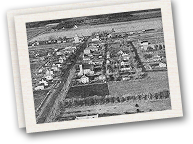Town Development
Churches
The first church in the area was called Egremont Presbyterian, and was built in 1899 just west of Sperling on SW36-6-3W. It was moved to Sperling in 1903. The Methodist Church was built in Sperling in the same year. These churches merged to form the United Church in 1924, and the Presbyterian Church was demolished. The new United Church was built in 1944, and it served until 1993. (The building is now a home and art studio, run by Ken Potter.) The Catholic Church was established in the former Waddell School building in 1935, and continued in use until 1972. (It is now the Golden Corner, a seniors' center.)
Schools
The first school was established in the area in 1897. Waddell No. 925 was located one mile north of present-day Sperling on SW32-6-2W. It served until a new school was built in Sperling in 1910: Sperling Consolidated No. 1488. The original building burned in 1924, and was quickly replaced with a red brick four-room school that served the area until it was closed in 1987. The building was demolished in 2006. Other schools in the Sperling area were Tremont to the south, and Lone Star and Lea-Bank to the east. These schools were consolidated into Sperling in the 1950s and 1960s.
In 1899, the first post office was located a half mile south of Waddell School, on the same quarter section (owned by Amos Davison), and was named Mariposa by postmasters Tom Bennett and his wife Allison (Waddell). After his death, she married John Smith. The post office was moved to Sperling in about 1902.
Father of Sperling
R.H.(Robert Henry) Waddell, nicknamed Yankee Bob because he lived in North Dakota for some time en route from Mount Forest, Ontario to Sperling, has earned the title as "Father of Sperling". He purchased the south half of 29-6-2W in 1900, just in time to have the Morden and Northwestern Railway build its new line along his property in 1901. He made some of his land available to them for a station and rail yards, and then undertook to develop a town site. He subdivided the area into lots, built a livery stable, boarding house (which later became the hotel), a general store, and numerous houses, and sold lots to others. Yankee Bob became quite wealthy, but he lived out his life quietly in Sperling, dying in 1938. Three of Sperling's street names are a reminder of him: Waddell, Robert, and Henry. Cousin Charles Waddell owned the north half of section 29, and the northernmost street is named Charles Street.
The Railway
The name Sperling was chosen by the Morden & Northwestern (or its successor, the Canadian Northern Railway) in recognition of a British financier, Sperling & Company, who provided financing for the construction of the railway.
It was common practice for railways to establish stations along its length about every seven to eight miles, and communities sprang up in similar manner to Sperling. Grain elevators were built at each town, providing delivery points that allowed farmers to haul their grain a manageable distance for horse and wagon. The first elevator established in Sperling was the Dominion in 1901, followed by the Ogilvie. Later came the Manitoba Pool, and then the Canadian Consolidated (later operated by United Grain Growers, and which burned in 1995).. The only surviving elevator, formerly the Manitoba Pool, is now operated by the N.M. Paterson Company.

